By: Robert, Automotive Historian/Researcher
Images: Courtesy of Robert Tate's Collection
Posted: 09.24.2015
As we take a look back over our American history and its influential automotive/industrial designers, we would be at a loss if we did not recognize the women pioneers who contributed to the success of automotive industrial design.
Margaret E. Knight was an engineer along with her niece Beatrice Davidson; they both designed and engineered the K-D automobile in 1912. During the 1930s, a few companies began hiring female designers. Betty Thatcher Oros joined Hudson in 1939 and later became a very successful designer and talented artist. Hudson was among the first automotive companies to employ women designers full time, by hiring Betty Thatcher in 1939.
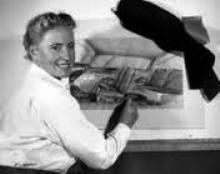 Helene Rother First Female DesignerOther early women who were a part of this great heritage include the late Helene Rother along with Helen Dryden. These talented women were a part of the early design teams that represented General Motors, Rambler and Studebaker.
Helene Rother First Female DesignerOther early women who were a part of this great heritage include the late Helene Rother along with Helen Dryden. These talented women were a part of the early design teams that represented General Motors, Rambler and Studebaker.
Helene Rother’s journey takes us all the way back to Leipzig, Germany where she was born. She became a gifted artist at an early age and later studied design and illustration at the Kunstgewer. She’d later complete her studies at the Bauhaus in Weimar which was an art school in Germany that operated from 1919 to 1933.
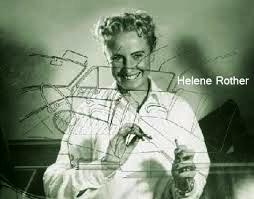 Helene RotherRother eventually relocated to Paris designing high fashion jewelry and other fashionable clothing and accessories. In 1941, she came to New York and her first employment assignment was designing illustrations for Marvel Comics. In 1942, she became a part of the talented team of designers at General Motors in Detroit.
Helene RotherRother eventually relocated to Paris designing high fashion jewelry and other fashionable clothing and accessories. In 1941, she came to New York and her first employment assignment was designing illustrations for Marvel Comics. In 1942, she became a part of the talented team of designers at General Motors in Detroit.
Helene worked with General Motors for four years before leaving to open her own industrial design studio in 1947. As her creative journey would continue she later became employed with the Nash Motor Car Company, designing many of the great interiors for Nash automobiles. Her career would span for many years from 1948 to 1956. In 1955, Rambler began selling new models for the consumer market.
They called some of their models “Glamour on wheels." Helene Rother designed many of the great interiors at the time. Automobile advertisements described them as stunning two-toned in plastic leather and fine upholstery. The Detroit News wrote that Rother was Detroit's first female automotive designer. Rother had a selling personality and was great at automotive interior designs. She knew exactly what women were looking for in a car, which helped her create some of the most stylish interior color and trim in the automotive industry.
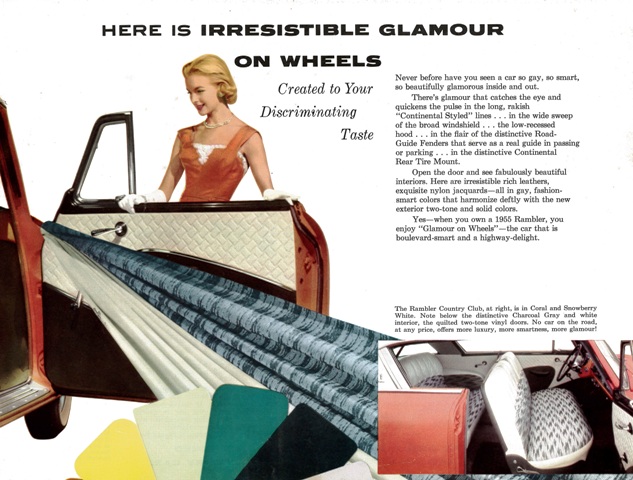 Rambler Interior Designer Helena Rother
Rambler Interior Designer Helena Rother
In 1953, Nash had received the coveted Jackson Medal award for outstanding automotive designs. This was a special career moment in her lifetime as she was a recipient of one of America's most sought-after awards in 1956; this would be her last signature on automotive interior designs. When Nash merged with Hudson to create American Motors, Rother left and started her consultant firm. Some of her clients included U.S Rubber, B.F Goodrich along with The Goodyear Tire & company and International Harvester along with many other non-automotive firms as well.
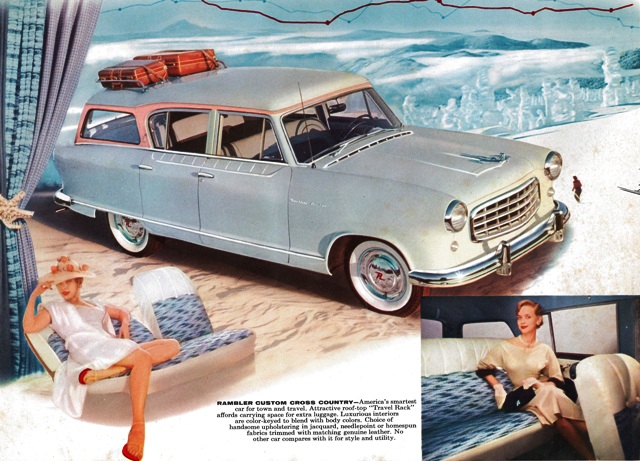 Rambler Custom Cross Country Wagon
Rambler Custom Cross Country Wagon
In her later years, Rother designed beautiful large stained-glass windows for churches which gave her the reputation as one of the best stained glass artists in the world. Today, Ms. Rother, is no longer with us. Unfortunately, she passed away in 1999. However, for her years of service and innovation, she will always be a part of our automotive history. (1908-1999)
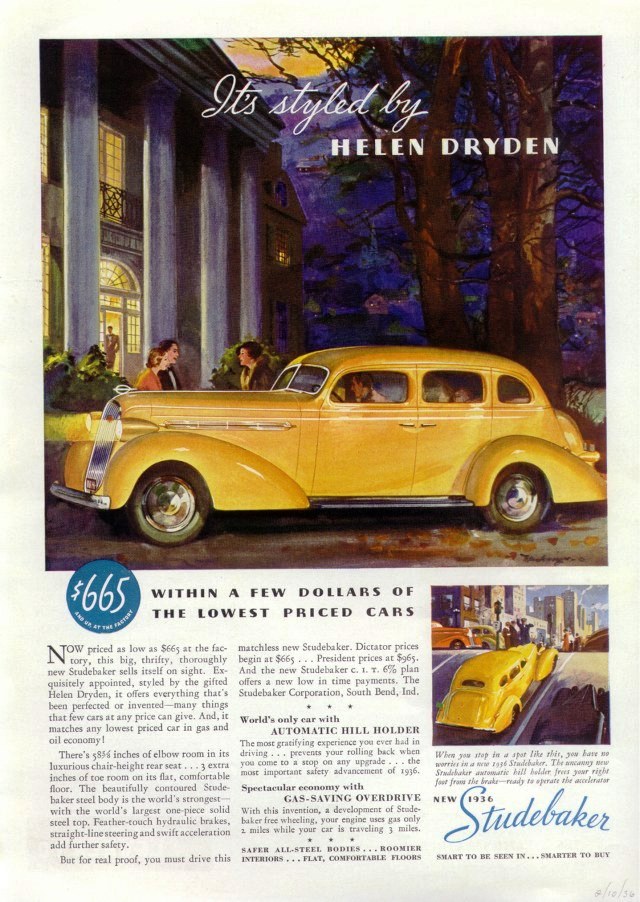 Studebaker Designed by Helen DrydenIt is also important to acknowledge the work of Helen Dryden, who was an automotive interior designer for the Studebaker design team from 1934 to 1937. Dryden was born in Baltimore, Maryland with a great artistic and talented ability for fashion. She studied under Hugh Breckenridge at the Philadelphia Academy of Fine Arts. Her journey began at a very early age when she sold a set of paper dolls and dresses to a newspaper for usage in a fashion section layout. Later she would become a great illustrator for Anne Rittenhouse’s fashion articles in Philadelphia.
Studebaker Designed by Helen DrydenIt is also important to acknowledge the work of Helen Dryden, who was an automotive interior designer for the Studebaker design team from 1934 to 1937. Dryden was born in Baltimore, Maryland with a great artistic and talented ability for fashion. She studied under Hugh Breckenridge at the Philadelphia Academy of Fine Arts. Her journey began at a very early age when she sold a set of paper dolls and dresses to a newspaper for usage in a fashion section layout. Later she would become a great illustrator for Anne Rittenhouse’s fashion articles in Philadelphia.
 37 Studebaker DesignsDuring the 1930s, the late industrial designer Raymond Loewy hired her to help him design the 1930’s Studebaker automobile interiors. Ms. Dryden’s interior work on the Studebaker Dictator and President Automobiles became a huge sensation which many people thoroughly enjoyed and admired.
37 Studebaker DesignsDuring the 1930s, the late industrial designer Raymond Loewy hired her to help him design the 1930’s Studebaker automobile interiors. Ms. Dryden’s interior work on the Studebaker Dictator and President Automobiles became a huge sensation which many people thoroughly enjoyed and admired.
Her industrial design work on the Studebaker interiors established herself as an world-class twentieth-century industrial designer. At the time many individuals considered her as one of the top industrial designers as she was one of the few women within the automotive design field. The New York Times magazine in 1956 said Dryden was once the highest-paid female artist in the country. Ms. Dryden unfortunately passed away in 1981. She too will always be a part of our automotive history.
A special thanks to Robert Tate, Automotive Historian and Researcher, for donating the story to the MotorCities Story of the Week program. Photographs are courtesy of Bob Tate’s Collection. (Bibliography: Lamm Michael & Holls Dave. “A century of automotive Style 100 years of American car design," 1996-1997.)
Please do not republish the story and/or photographs without permission of MotorCities National Heritage Area. If you would like to contribute an article for the MotorCities newsletter, email This email address is being protected from spambots. You need JavaScript enabled to view it. or call 313-259-3425.



